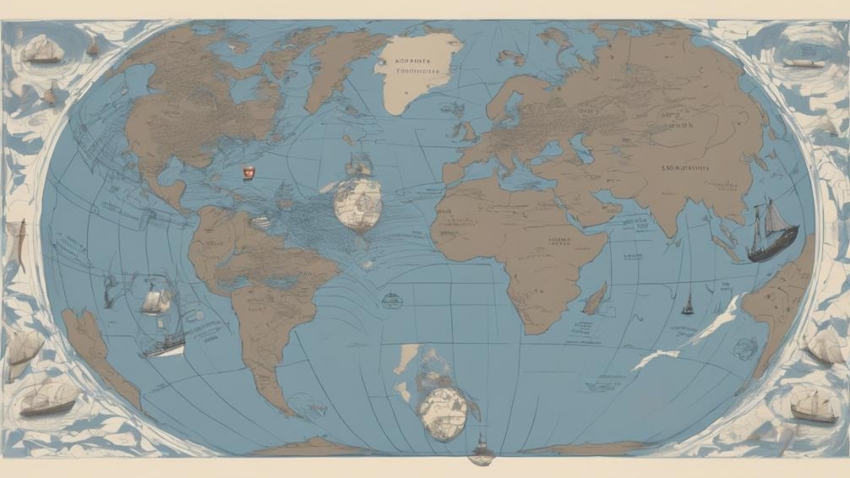
Navigating the Waters of International Trade Agreements
You're about to navigate the complex world of international trade agreements, where understanding the intricacies of CETA, TTIP, EFTA, and the EU-Japan EPA can make all the difference in your business's success. You'll need to stay on top of tariff reductions, regulatory cooperation, and market access to stay competitive. As you explore the benefits of compliance, from expanded customer bases to streamlined logistics, you'll discover how to reduce trade costs and delays. Stay informed, and you'll reveal the secrets to enhancing your business's global competitiveness. Now, take the next step into the world of international trade agreements.
Understanding Key Trade Agreements
As European freight forwarders, you need to navigate a complex web of international trade agreements to optimize your operations and capitalize on trade benefits. You can't afford to overlook the intricacies of trade agreements, as they can greatly impact your business. Understanding key trade agreements is vital to staying competitive in the global market.
CETA, for instance, offers a substantial reduction in tariffs and promotes regulatory cooperation between the EU and Canada. This means you can enjoy preferential access to the Canadian market, giving you a competitive edge. Similarly, TTIP aims to establish an in-depth trade agreement between the EU and the US, covering sectors like textiles and transportation. By staying informed about the developments of TTIP, you can anticipate and adapt to changes in the US market.
EFTA agreements with countries like Canada, Mexico, and South Korea provide preferential market access and tariff reductions. This means you can expand your business into new markets, while minimizing the costs associated with tariffs. The EU-Japan EPA is another significant agreement that eliminates tariffs on many products, simplifies customs procedures, and improves market access to Japan. By grasping the nuances of these trade agreements, you can make informed decisions to optimize your operations and capitalize on trade benefits.
Benefits of Trade Agreement Compliance
In addition, by adhering to trade agreements like CETA and TTIP, you can access a range of benefits that can greatly enhance your business operations and competitiveness in the global market. Compliance with these agreements offers preferential market access and tariff reductions, allowing you to expand your customer base and increase revenue. Furthermore, trade agreement compliance streamlines customs procedures and promotes regulatory cooperation, reducing the complexity and cost of international trade.
Streamlining Supply Chain Management
As you navigate international trade agreements, you'll want to focus on streamlining your supply chain management to maximize efficiency. This means simplifying your logistics operations and implementing efficient inventory management systems. By doing so, you'll be able to reduce costs, improve delivery times, and ultimately, boost your competitiveness in the global market.
Simplified Logistics Operations
Streamlining supply chain management through international trade agreements enables you to tap into reduced tariffs and simplified customs procedures, ultimately leading to increased efficiency in logistics operations. By understanding the benefits of trade agreements like CETA, TTIP, and EU-Japan EPA, you can optimize your logistics operations and expand your market reach.
Here are just a few ways simplified logistics operations can benefit your business:
- Reduced costs: Lower tariffs and streamlined customs procedures translate to cost savings, which you can reinvest in your business.
- Increased market access: Simplified logistics operations enable you to tap into new markets and expand your customer base.
- Improved efficiency: With enhanced regulatory cooperation, you can optimize your supply chain and reduce transit times, getting your products to market faster.
Efficient Inventory Management
You can greatly reduce supply chain costs and improve efficiency by implementing efficient inventory management practices that optimize stock levels and minimize overstocking or stockouts. This is particularly essential in international trade, where inaccurate inventory management can lead to costly delays and lost revenue. By leveraging advanced inventory tracking systems, you can accurately forecast demand and maintain ideal stock levels, ensuring that your products reach customers on time and in the right quantities. Implementing just-in-time inventory practices can also help reduce excess inventory and storage costs, freeing up resources for more strategic investments. Additionally, technologies like RFID and barcode systems can enhance inventory visibility and accuracy, leading to improved supply chain performance. By streamlining your inventory management, you'll be better equipped to navigate the complexities of international trade agreements and stay ahead of the competition.
Navigating Tariff and Non-Tariff Barriers
When dealing with international trade agreements, you must understand the complexities of tariff and non-tariff barriers, which can greatly impact your business's bottom line. Tariff barriers, specifically, can be a significant hurdle. You see, tariff barriers are taxes imposed on imported goods, with bound tariffs setting the maximum rates countries commit not to exceed. However, applied tariffs are the actual rates imposed, which can be lower than bound tariffs, creating tariff water, the gap between the two rates.
Here are three key points to keep in mind when managing tariff barriers:
- High tariff water provides flexibility: High tariff water allows governments to negotiate lower bound rates, giving them room to maneuver in trade negotiations.
- Low tariff water limits flexibility: Low tariff water limits policy maneuverability in trade agreements but can lead to more predictable trade policies.
- Flexibility in tariff adjustments: Countries can raise tariffs under specific categories like national security or in response to unfair trade practices, allowing for flexibility in trade negotiations.
Market Access and Logistics Efficiency
As you navigate the complexities of international trade agreements, securing efficient market access and logistics becomes essential, especially in agreements like the EU-Japan EPA, which has eliminated tariffs on many products and simplified customs procedures. You're well aware that accessing new markets can be a game-changer for your business, and that's exactly what the EU-Japan EPA offers. By removing tariffs on many products, this agreement opens up new opportunities for European businesses to tap into Japan's lucrative market.
When it comes to logistics, you know that efficiency is key. That's why the streamlined procedures under the EU-Japan EPA are a welcome development. With simplified customs procedures, you can now move goods more quickly and reliably, reducing transit times and costs. This is particularly beneficial for freight forwarders in Europe, who can now capitalize on the agreement's benefits.
In the world of global trade, understanding key agreements like the EU-Japan EPA is essential for optimizing operations and capitalizing on trade benefits. By grasping the intricacies of this agreement, you'll be better equipped to navigate the complexities of international trade and stay ahead of the competition. With improved market access and logistics efficiency, you'll be well-positioned to take advantage of the vast opportunities available in the global trade arena.
Reducing Trade Costs and Delays
By capitalizing on trade agreements like CETA, TTIP, and EFTA, freight forwarders can greatly decrease trade costs and delays, opening up new business opportunities and enhancing their competitive edge. As you navigate the complex landscape of international trade, understanding these agreements can help you optimize your operations and reduce costs.
Here are three key ways trade agreements can benefit your business:
- Tariff reductions: Agreements like CETA, TTIP, and EFTA reduce or eliminate tariffs on various goods, directly lowering your trade costs.
- Streamlined customs procedures: The EU-Japan EPA, for example, simplifies customs procedures, reducing delays and increasing logistics efficiency.
- Improved market access: By reducing trade barriers, these agreements give you greater access to new markets and customers, increasing your business potential.
Enhancing Competitiveness Globally
You can greatly enhance your competitiveness in the global market by understanding and leveraging key international trade agreements, such as CETA, TTIP, EFTA, and the EU-Japan EPA. By tapping into these agreements, you can capitalize on trade benefits, optimize operations, and expand your business network. This is especially vital in today's competitive landscape, where companies need to stay ahead of the curve to thrive.
For instance, the United States-Mexico-Canada Agreement (USMCA) has created new opportunities for businesses to penetrate the North American market. By understanding the intricacies of this agreement, you can streamline your customs procedures, reduce tariffs, and increase your market share. Similarly, the EU-Japan EPA has opened up new avenues for trade between Europe and Japan, offering preferential access to markets and promoting regulatory cooperation.
Overcoming Trade Agreement Complexities
As you navigate the complexities of international trade agreements, you'll need to crack the code of trade jargon, navigate the intricacies of tariff systems, and simplify compliance rules to guarantee smooth operations. You'll need to understand the nuances of trade agreements to optimize your business strategy. By mastering these skills, you'll be able to overcome the complexities and reap the benefits of international trade agreements.
Decoding Trade Jargon
When understanding international trade agreements, grasping the nuances of tariff water is essential to understanding the flexibility countries have in setting tariffs within WTO rules. As you navigate the complex world of global trade, being aware of tariff water can give you an edge in negotiations and agreements.
Here's what you need to know:
- High tariff water provides policy maneuverability in trade negotiations and agreements, allowing countries to adjust tariffs according to their needs.
- Low tariff water limits the ability to adjust tariffs, potentially leading to more predictable trade policies.
- Flexibility in tariff adjustments allows countries to raise tariffs under specific circumstances like national security concerns, while complying with WTO rules.
Navigating Tariff Systems
Understanding tariff systems requires a thorough grasp of bound and applied tariffs, as well as the strategic use of tariff water, to overcome complexities in international trade agreements. You need to understand the difference between bound tariffs, which are the maximum rates a country can charge, and applied tariffs, which are the actual rates imposed on imports. The gap between these two rates is called tariff water, and it's a vital concept in maneuvering international trade agreements. You'll find that countries with high tariff water have more flexibility to negotiate lower bound rates within WTO rules, while those with low tariff water have limited policy maneuverability but enjoy more predictable trade policies. As you navigate tariff systems, remember that countries strategically use tariff water to implement policy goals and negotiate with trading partners. When adjusting tariffs beyond bound rates, compliance with WTO rules is essential to avoid legal implications. By mastering tariff systems, you'll be better equipped to maneuver the complexities of international trade agreements and make informed decisions about duties and tariffs.
Simplifying Compliance Rules
You'll find that compliance rules in international trade agreements can be overwhelmingly complex due to varying regulations, tariffs, and legal requirements. Understanding and adhering to these guidelines is vital to avoid legal issues and maintain reliability in trade relationships. To simplify compliance rules, you can utilize various tools and strategies.
Here are three ways to navigate the complexities of trade agreements:
- Compliance software: Leverage technology to streamline compliance processes and reduce errors.
- Legal counsel and industry expertise: Consult with legal professionals and industry experts to make sure you're meeting all requirements.
- Certifications and audits: Obtain relevant certifications and conduct regular audits to ensure compliance and identify areas for improvement.
Frequently Asked Questions
What Are the Five Major Trade Agreements?
You're about to uncover the secrets of the global trade landscape! You're wondering what the five major trade agreements are, and you're about to find out. Get ready to expand your business networks and capitalize on trade benefits! The answers are: CETA, TTIP, EFTA agreements, the EU-Japan EPA, and… (drumroll please)… none, there are only four major agreements! Now, are you ready to dive deeper and master the world of international trade?
What Are the Four Basic Categories of International Trade Agreements?
You're looking to understand the basics of international trade agreements. Well, you're in the right place! There are four main categories to get familiar with: Free Trade Agreements, Customs Unions, Common Markets, and Economic Unions. Each has its own benefits and levels of integration. You'll find that they differ in how they handle tariffs, quotas, and the flow of goods and services between member countries.
What Are the Main Purposes of International Trade Agreements?
You're wondering what the main purposes of international trade agreements are. Well, you're about to find out! These agreements aim to promote economic cooperation, reduce trade barriers, and create a stable trading environment. They facilitate the movement of goods, services, and investments, while protecting intellectual property rights. By doing so, they drive economic growth and development, creating mutual benefits for all parties involved.
What Is an Example of a Trade Agreement AP Human Geography?
You're curious about a trade agreement example, aren't you? Let's explore the captivating world of free trade deals! A shining star is the Comprehensive Economic and Trade Agreement (CETA) between the EU and Canada. This agreement slashes tariffs on various goods, fostering a smoother flow of trade. By eliminating hurdles, CETA boosts economic growth and creates new opportunities for businesses and consumers alike.











